A Study on the Construction and Evaluation of the Water Resource Reutilization System for Farmland Diversion and Drainage
Abstract
1. Introduction
2. Materials and Methods
2.1. Study Area
2.1.1. Hydrology Characteristics and Water Resources
2.1.2. Geology Condition
2.1.3. Water Environmental Quality
2.2. Methods
2.2.1. System Parameter Determination and Construction
2.2.2. Living Water Regulation
2.2.3. Ecological Recycling
2.3. Quality Assurance and Control
3. Results
3.1. Operating Condition Testing
- (1)
- Drought and normal period: To ensure an adequate water supply for domestic use in village households, the water amount will be increased. This will be achieved by utilizing newly constructed gate stations and renovated irrigation pumping stations to replenish water from the surrounding river into the internal main stream of the of the QY River and the level Ⅳ residential river. Additionally, this approach will also enhance the ecological flow of the drainage river.
- (2)
- Agricultural irrigation period: Utilizing the rearranged canal system and repositioned irrigation pumping stations to extract water to enter the acreage in order to ensure agricultural production.
- (3)
- Farmland drainage period: The drainage canal system routes stagnant field water through a series of collection and purification facilities, thereby reducing the initial pollution load into the drainage river. The drainage ditch then uses depth treatment technology to minimize pollutants entering the QY River.
- (4)
- Flood and rainy period: All gates should be open to ensure that internal waterlogging drains to the external river. Open the drainage pump station in case of an emergency.
3.2. Water Replenishing Cycle Period
3.3. Agricultural Irrigation Period
3.4. Farmland Drainage Period
3.5. Flood and Rainy Period
4. Discussion
4.1. Water Resource Optimization
4.1.1. Water Demand
Domestic Water Demand
Water Demand for Production
Ecological Water Demand
4.1.2. Water Supply
4.1.3. Water Conservation
Village Water Conservation
Agricultural Water Conservation
4.1.4. Water Supply and Demand Balance
4.2. Water Quality Enhancement
4.3. Water Security and Agricultural Production Security
4.3.1. Flood Control and Drainage
4.3.2. Assurance of Irrigation
5. Conclusions
Author Contributions
Funding
Data Availability Statement
Conflicts of Interest
References
- Volk, J.; Yerokun, O. Effect of Application of Increasing Concentrations of Contaminated Water on the Different Fractions of Cu and Co in Sandy Loam and Clay Loam Soils. Agriculture 2016, 6, 64. [Google Scholar] [CrossRef]
- Jaiswal, D.; Elliott, H.A. Long-term phosphorus fertility in wastewater-irrigated cropland. J. Environ. Qual. 2011, 40, 214–223. [Google Scholar] [CrossRef] [PubMed]
- Lixin, T.; Yu, Y.; Youhong, S.; Baili, F. Rehydration under extreme drought conditions affected rhizosphere microorganisms more than bulk soil in broomcorn millet farmland. Agric. Water Manag. 2024, 295, 108781. [Google Scholar]
- Lottermoser, B.G. Effect of long-term irrigation with sewage effluent on the metal content of soils, Berlin, Germany. Environ. Geochem. Health 2012, 34, 67–76. [Google Scholar] [CrossRef]
- Garcia-Vila, M.; Suzuki, H.; Ahmad, W.; Ali, A.; Pek, E.; Salman, M. Irrigation development as a booster of the multifunctional roles of paddy rice. Irrig. Drain. 2023, 72, 1317–1332. [Google Scholar] [CrossRef]
- Wesstrom, I.; Messing, I. Effects of controlled drainage on N and P losses and N dynamics in a loamy sand with spring crops. Agric. Water Manag. 2007, 87, 229–240. [Google Scholar] [CrossRef]
- Christen, E.W.; Skehan, D. Design and management of subsurface horizontal drainage to reduce salt loads. ASCE J. Irrig. Drain. Eng. 2001, 127, 148–155. [Google Scholar] [CrossRef]
- Xiaoyue Z, Lei C, Yu Y, Zhenyao S, Water quality variability affected by landscape patterns and the associated temporal observation scales in the rapidly urbanizing watershed. J. Environ. Manag. 2021, 298, 113523. [CrossRef]
- Usio, N.; Imada, M.; Nakagawa, M.; Akasaka, M.; Takamura, N. Effects of pond draining on biodiversity and water quality of farm ponds. Conserv. Biol. 2013, 27, 1429–1438. [Google Scholar] [CrossRef]
- Borin, M.; Tocchetto, D. Five year water and nitrogen balance for a constructed surface flow wetland treating agricultural drainage waters. Sci. Total Environ. 2007, 380, 38–47. [Google Scholar] [CrossRef]
- Hanrahan, B.R.; King, K.W.; Duncan, E.W.; Shedekar, V.S. Cover crops differentially influenced nitrogen and phosphorus loss in tile drainage and surface runoff from agricultural fields in Ohio, USA. J. Environ. Manag. 2021, 293, 112910. [Google Scholar] [CrossRef] [PubMed]
- Kęsicka, B.; Stasik, R.; Kozłowski, M. Effects of modelling studies on controlled drainage in agricultural land on reduction of outflow and nitrate losses-a meta-analysis. PLoS ONE 2022, 17, e0267736. [Google Scholar] [CrossRef] [PubMed]
- Sim, B.-R.; Kim, H.-C.; Kim, C.-S.; Kim, J.-H.; Park, K.-W.; Lim, W.-A.; Lee, W.-C. Seasonal Distributions of Phytoplankton and Environmental Factors Generate Algal Blooms in the Taehwa River, South Korea. Water 2020, 12, 3329. [Google Scholar] [CrossRef]
- Al-Hammad, B.A.; Abd El-Salam, M.M.; Ibrahim, S.Y. Quality of wastewater reuse in agricultural irrigation and its impact on public health. Environ. Monit. Assess. 2014, 186, 7709–7718. [Google Scholar] [CrossRef] [PubMed]
- Avci, H.; Deveci, T. Assessment of trace element concentrations in soil and plants from cropland irrigated with wastewater. Ecotoxicol. Environ. Saf. 2013, 98, 283–291. [Google Scholar] [CrossRef] [PubMed]
- Stańczuk-Gałwiaczek, M.; Sobolewska-Mikulska, K.; Ritzema, H.; van Loon-Steensma, J.M. Integration of water management and land consolidation in rural areas to adapt to climate change: Experiences from Poland and the Netherlands. Land Use Policy 2018, 77, 498–511. [Google Scholar] [CrossRef]
- Jamshed, A.; Birkmann, J.; Rana, I.A.; Feldmeyer, D. The effect of spatial proximity to cities on rural vulnerability against flooding: An indicator based approach—Sciencedirect. Ecol. Indic. 2020, 118, 106704. [Google Scholar] [CrossRef]
- Thompson, D.M.; Puklin, L.S.; Marshall, A.E. Marshall, The long-term impact of channel stabilization using gabion structures on Zealand River, New Hampshire. Ecol. Eng. 2016, 95, 779–792. [Google Scholar] [CrossRef]
- Geng, H.; Ding, X.; Du, H.; Shi, J.; Li, C.; Li, X. Application of Self-Compacting Steel Fiber Reinforced Concrete for Pervious Frames Used for River Revetment. Appl. Sci. 2022, 12, 10457. [Google Scholar] [CrossRef]
- Kiss, T.; Amissah, G.J.; Fiala, K. Bank Processes and Revetment Erosion of a Large Lowland River: Case Study of the Lower Tisza River, Hungary. Water 2019, 11, 1313. [Google Scholar] [CrossRef]
- Feng, K.; Hubacek, K.; Pfister, S.; Yu, Y.; Sun, L. Virtual scarce water in China. Environ. Sci. Technol. 2014, 48, 7704–7713. [Google Scholar] [CrossRef] [PubMed]
- Badrzadeh, N.; Samani, J.M.V.; Mazaheri, M.; Kuriqi, A. Evaluation of management practices on agricultural nonpoint source pollution discharges into the rivers under climate change effects. Sci. Total Environ. 2022, 838, 156643. [Google Scholar] [CrossRef] [PubMed]
- Raudina, T.V.; Smirnov, S.V.; Lushchaeva, I.V.; Istigechev, G.I.; Kulizhskiy, S.P.; Golovatskaya, E.A.; Shirokova, L.S.; Pokrovsky, O.S. Seasonal and Spatial Variations of Dissolved Organic Matter Biodegradation along the Aquatic Continuum in the Southern Taiga Bog Complex, Western Siberia. Water 2022, 14, 3969. [Google Scholar] [CrossRef]
- Wang, H.; He, P.; Shen, C.; Wu, Z. Effect of irrigation amount and fertilization on agriculture non-point source pollution in the paddy field. Environ. Sci. Pollut. Res. 2019, 26, 10363–10373. [Google Scholar] [CrossRef] [PubMed]
- Stampfli, N.; Madramootoo, C.A. Water table management: A technology for achieving more crop per crop. Paper submitted for the nineth international drainage workshop (ICID). Irrig. Drain. Sys. 2006, 20, 267–282. [Google Scholar] [CrossRef]
- The State Environmental Protection Administration of China. Water and Wastewater Monitoring and Analysis Methods, 4th ed.; China Environmental Science Press: Beijing, China, 2002. [Google Scholar]
- The State Environmental Protection Administration of China. The Technical Specification for Soil Environmental Monitoring; China Environmental Science Press: Beijing, China, 2004. [Google Scholar]
- The Ministry of Water Resources of China. The Hydrological Data Testing Was Duly Conducted in Accordance with the Specification for Geodesic Survey in Hydrology; The Ministry of Water Resources of China: Beijing, China, 2014. [Google Scholar]
- Tokuda, D.; Kim, H.; Yamazaki, D.; Oki, T. Development of a global river water temperature model considering fluvial dynamics and seasonal freeze-thaw cycle. Water Resour. Res. 2019, 55, 1366–1383. [Google Scholar] [CrossRef]
- Turnipseed, C.; Konsoer, K.; Richards, D.; Willson, C. Numerical modeling of two-dimensional hydrodynamics in a highly curving and actively evolving neck cutoff under different hydrologic conditions. Water Resour. Res. 2021, 57, e2020WR027329. [Google Scholar] [CrossRef]
- Glas, M.; Glock, K.; Tritthart, M.; Liedermann, M.; Habersack, H. Hydrodynamic and morph dynamic sensitivity of a river’s main channel to groyne geometry. J. Hydraul. Res. 2018, 56, 714–726. [Google Scholar] [CrossRef]
- Sauvé, S.; Lamontagne, S.; Dupras, J.; Stahel, W. Circular economy of water: Tackling quantity, quality and footprint of water. Environ. Dev. 2021, 39, 100651. [Google Scholar] [CrossRef]
- Gao, C.; Lin, M.; He, L.; Tang, M.; Ma, J.; Sun, W. The Impact of Water-Saving Irrigation on Rice Growth and Comprehensive Evaluation of Irrigation Strategies. Agronomy 2024, 14, 1363. [Google Scholar] [CrossRef]
- Atwill, R.L.; Spencer, G.D.; Bond, J.A.; Walker, T.W.; Phillips, J.M.; Mills, B.E.; Krutz, L.J. Establishment of thresholds for alternate wetting and drying irrigation management in rice. Agron. J. 2023, 115, 1735–1745. [Google Scholar] [CrossRef]
- Graham-Acquaah, S.; Siebenmorgen, T.J.; Reba, M.L.; Massey, J.H.; Mauromoustakos, A.; Adviento-Borbe, A.; January, R.; Burgos, R.; Baltz-Gray, J. Impact of alternative irrigation practices on rice quality. Cereal Chem. 2019, 96, 815–823. [Google Scholar] [CrossRef]
- Dos Santos, M.P.; Heinemann, A.B.; Stone, L.F.; da Silva, M.A.S.; Lanna, A.C.; dos Santos, A.B. Phenology, gas exchange, biomass accumulation, and irrigated rice yield under alternative irrigation managements. Agron. J. 2024, 116, 542–562. [Google Scholar] [CrossRef]
- Zubaidi, S.L.; Gharghan, S.K.; Jayne, D.; Alkhaddar, R.M.; Mawada, A. Short-term urban water demand prediction considering weather factors. Water Resour. Manag. 2018, 32, 4527–4542. [Google Scholar] [CrossRef]
- Lihong, Z. Prediction model of ecological environmental water demand based on big data analysis. Environ. Technol. Innov. 2021, 21, 101196. [Google Scholar]
- Lu, S.; Cai, W.; Shao, W.; Taghizadeh-Hesary, F.; Faisal, M.; Zhang, H.; Xue, Y. Ecological Water Requirement in Upper and Middle Reaches of the Yellow River Based on Flow Components and Hydraulic Index. Int. J. Environ. Res. Public Health 2021, 18, 10956. [Google Scholar] [CrossRef] [PubMed]
- Davis, K.F.; Seveso, A.; Rulli, M.C.; D’Odorico, P. Water Savings of Crop Redistribution in the United States. Water 2017, 9, 83. [Google Scholar] [CrossRef]
- Thiam, D.R.; Dinar, A.; Ntuli, H. Promotion of residential water conservation measures in South Africa: The role of water-saving equipment. Environ. Econ. Policy Stud. 2021, 23, 173–210. [Google Scholar] [CrossRef]
- Canfield, D.E.; Hoyer, M.V.; Bachmann, R.W.; Bigham Stephens, D.; Ruiz-Bernard, I. Water quality changes at an Outstanding Florida Water: Influence of stochastic events and climate variability. Lake Reserv. Manag. 2016, 32, 297–313. [Google Scholar] [CrossRef]
- Cloern, J.E. Patterns, pace, and processes of water-quality variability in a long-studied estuary. Limnol Ocean. 2019, 64, S192–S208. [Google Scholar] [CrossRef]
- Zhang, L.; Ma, Q.; Zhao, Y.; Chen, H.; Hu, Y.; Ma, H. China’s strictest water policy: Reversing water use trends and alleviating water stress. J. Environ. Manag. 2023, 345, 118867. [Google Scholar] [CrossRef] [PubMed]
- Van Loon-Steensma, J.M.; Vellinga, P. Robust, multifunctional flood defenses in the dutch rural riverine area. Nat. Hazards Earth Syst. Sci. 2014, 14, 1085–1098. [Google Scholar] [CrossRef]
- Obayomi, O.; Bernstein, N.; Edelstein, M.; Vonshak, A.; Ghazayarn, L.; Ben-Hur, M.; Tebbe, C.C.; Gillor, O. Importance of soil texture to the fate of pathogens introduced by irrigation with treated wastewater. Sci. Total Environ. 2019, 653, 886–896. [Google Scholar] [CrossRef] [PubMed]
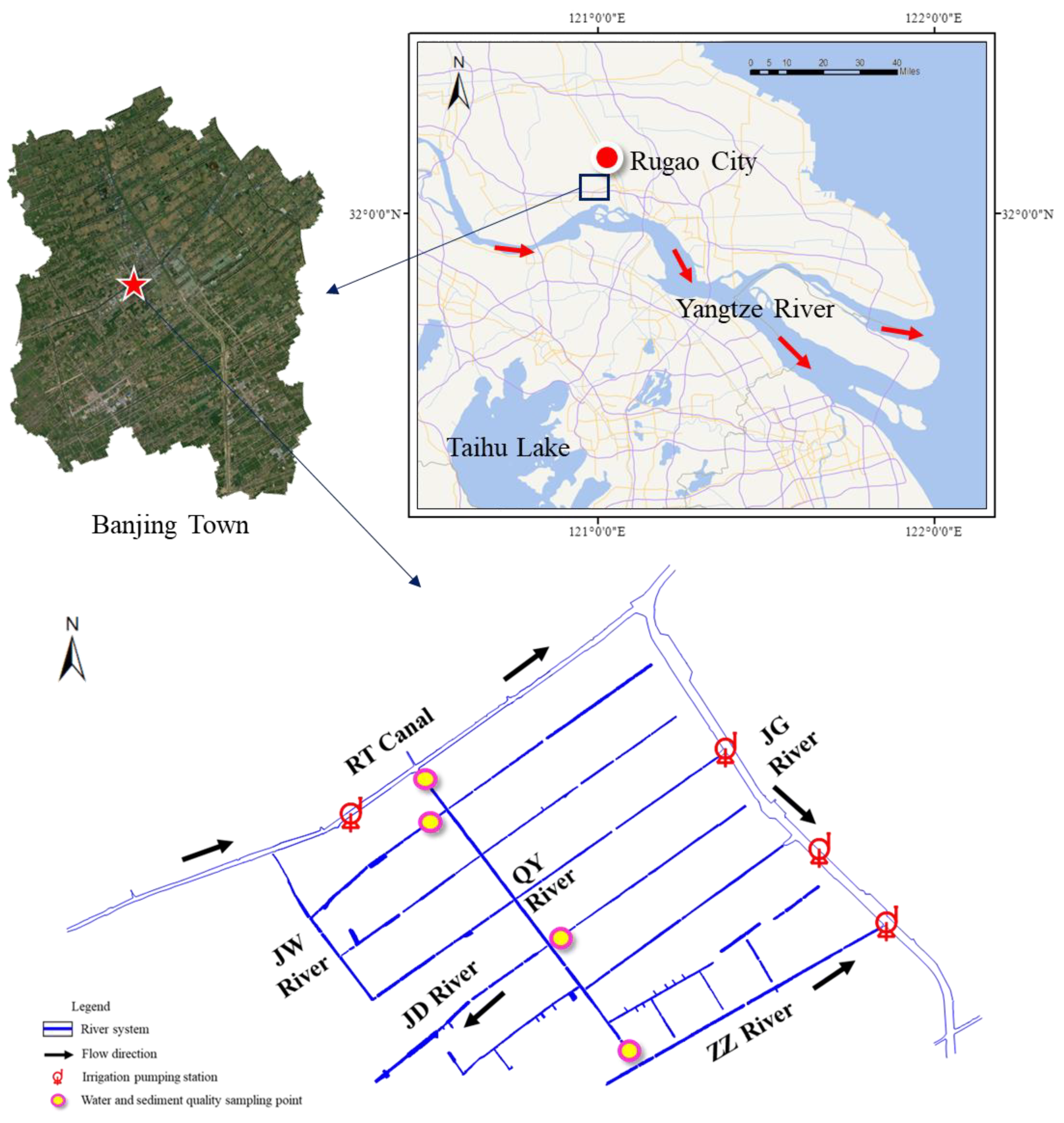
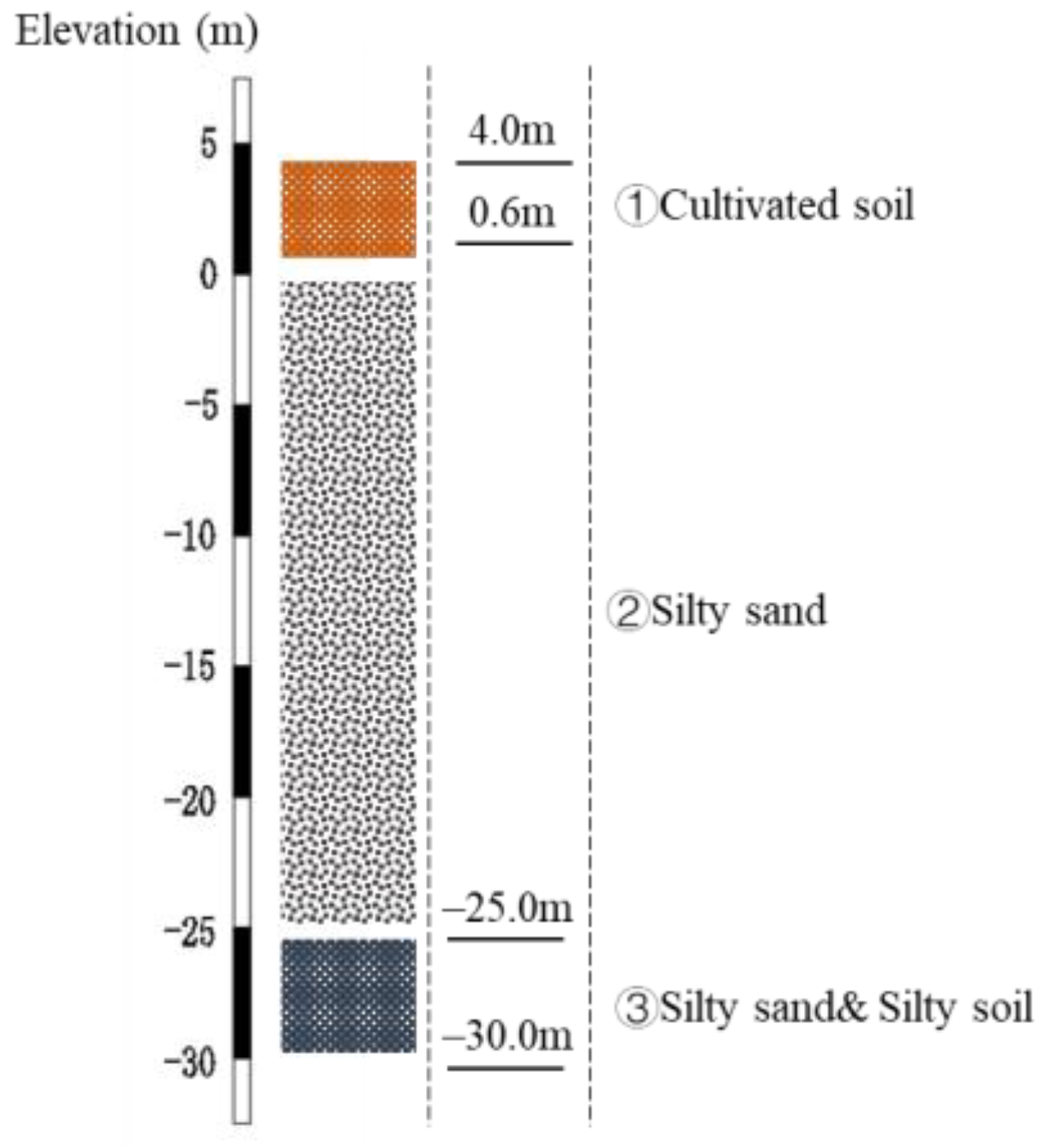
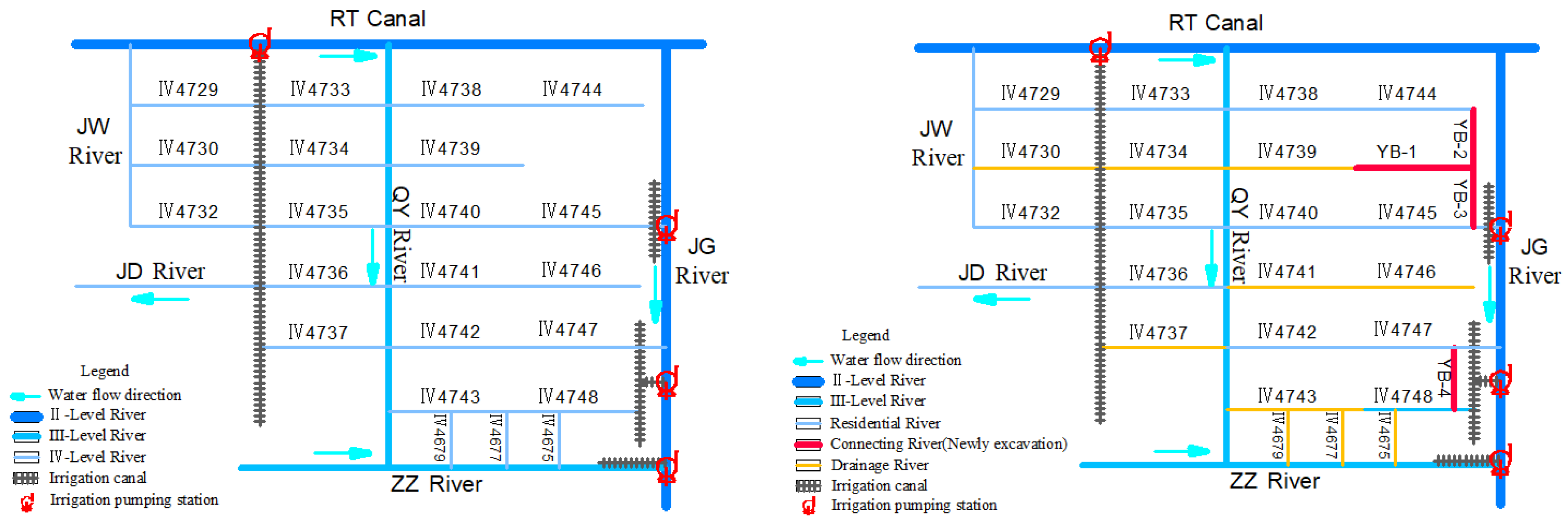


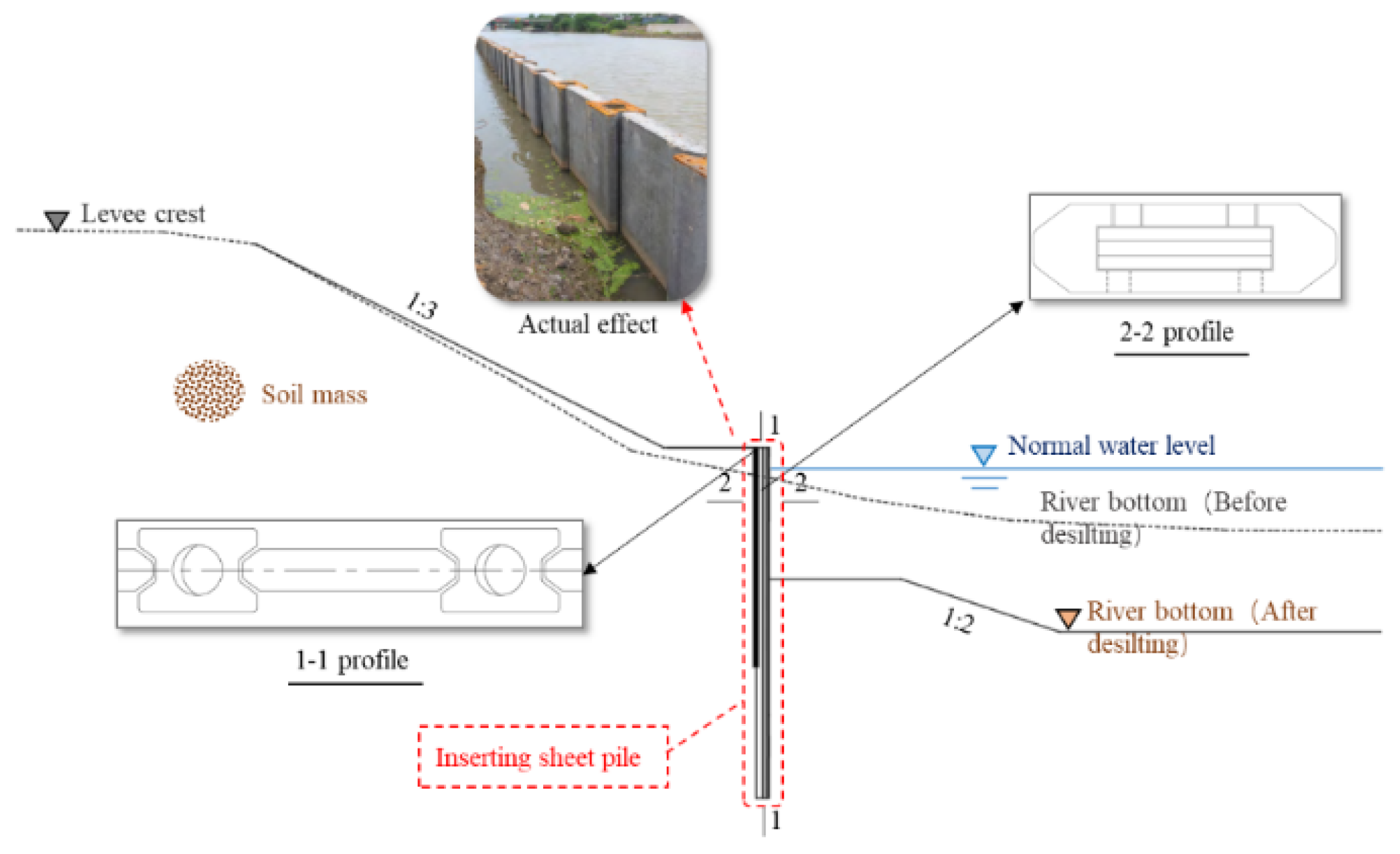

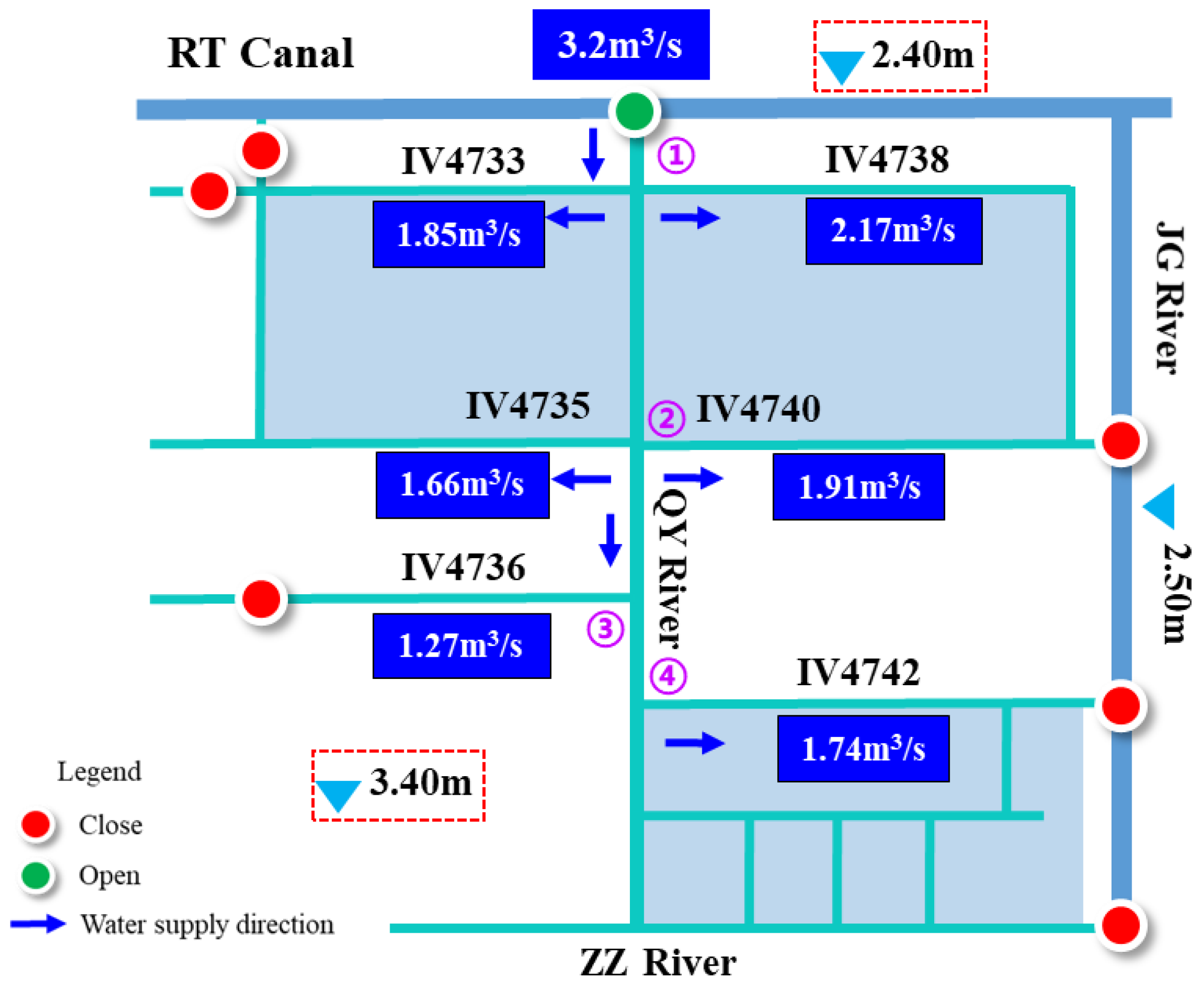
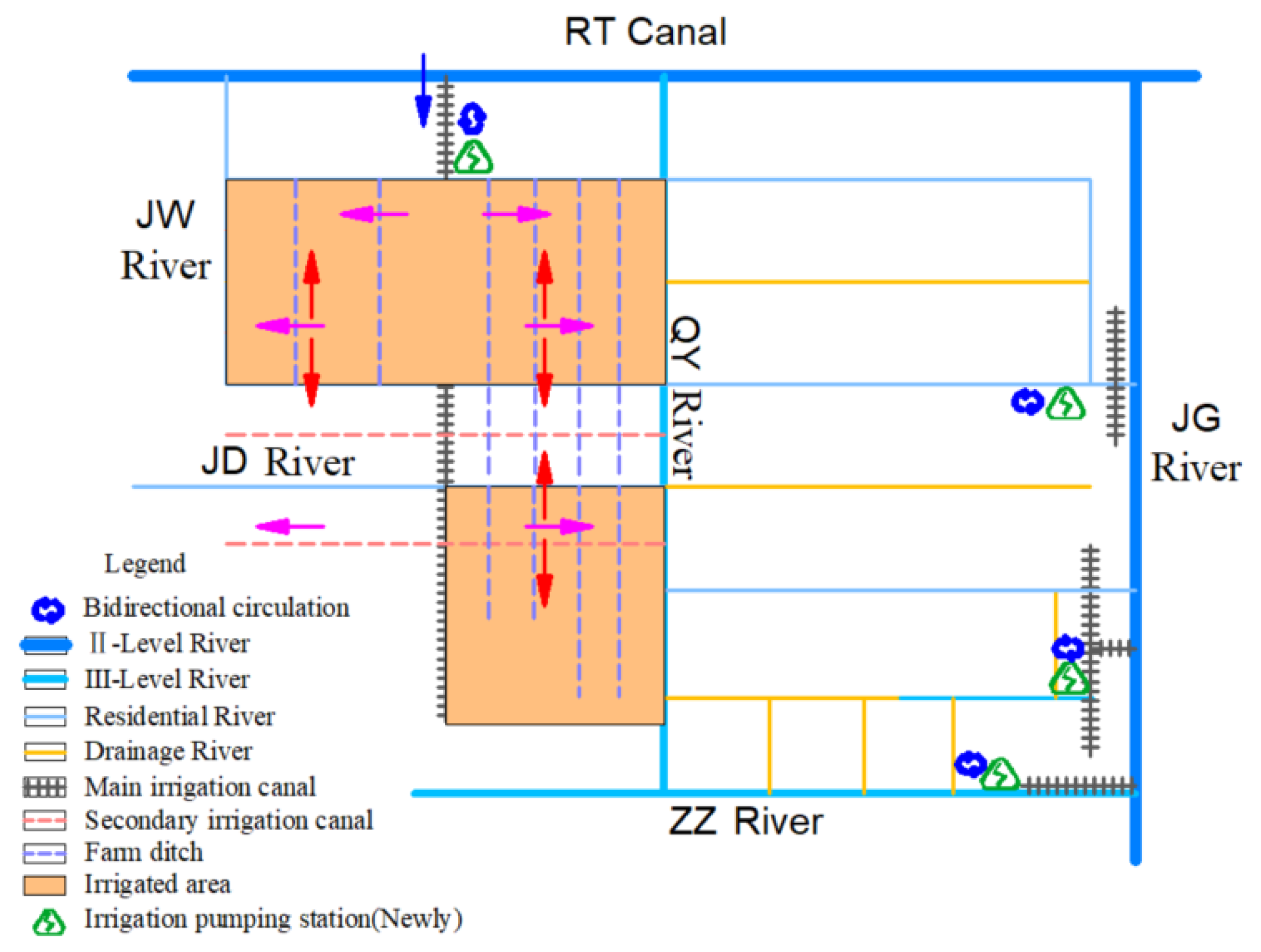

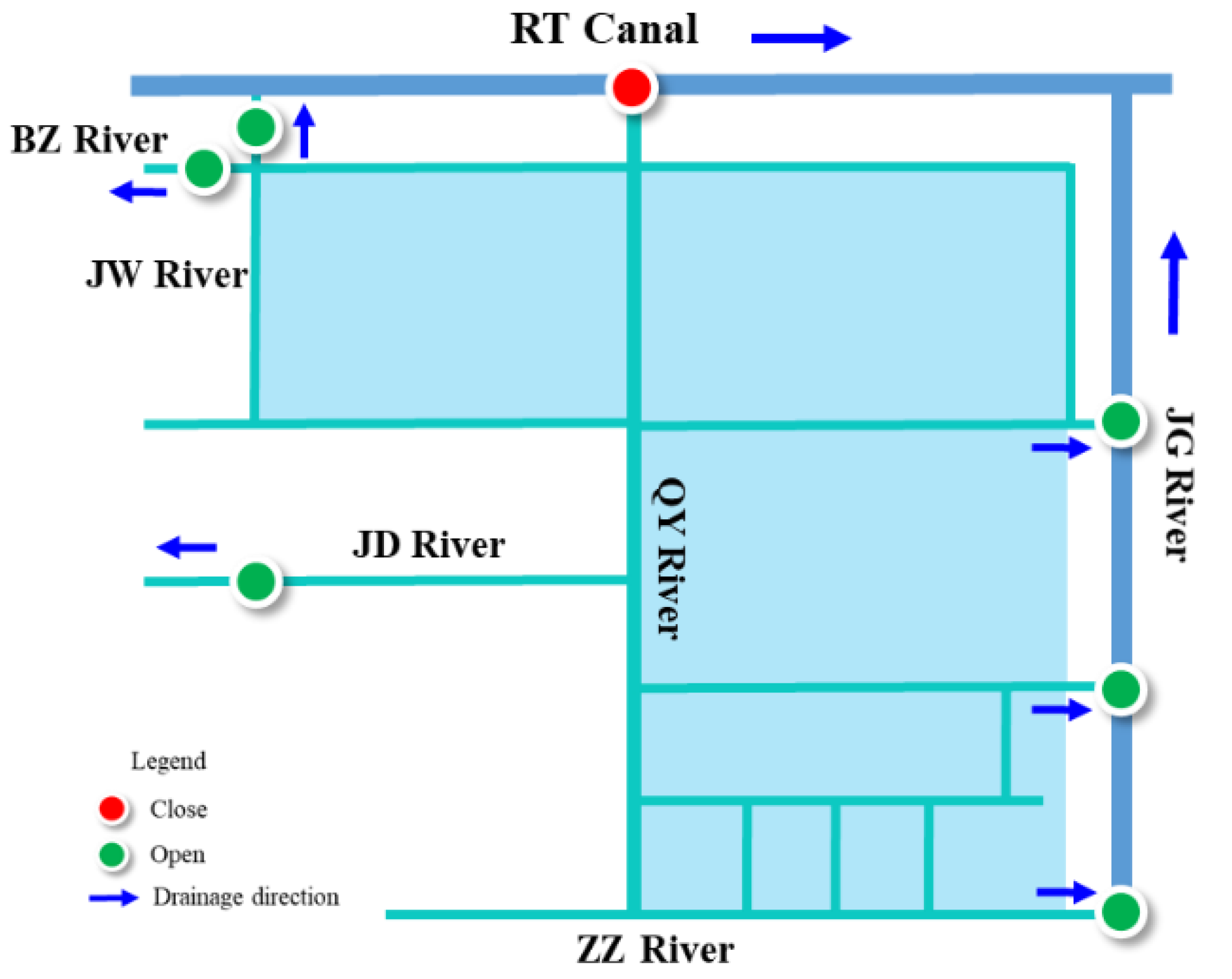
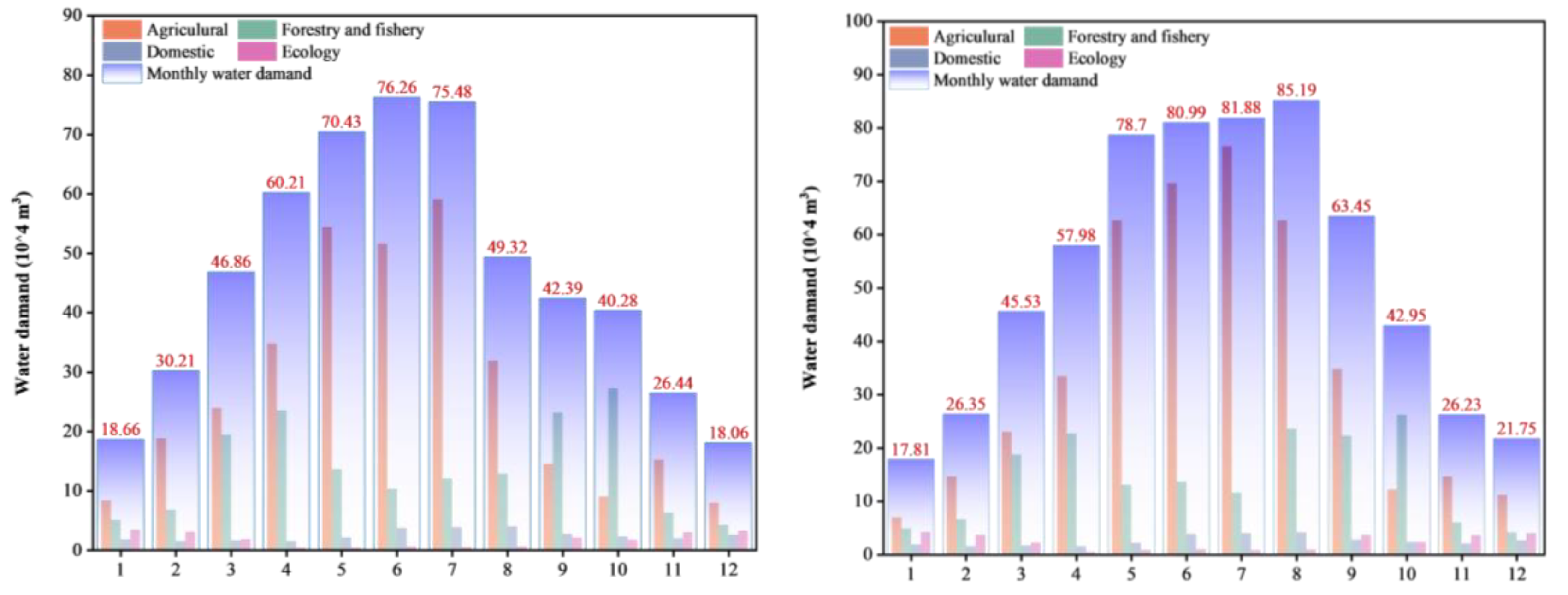
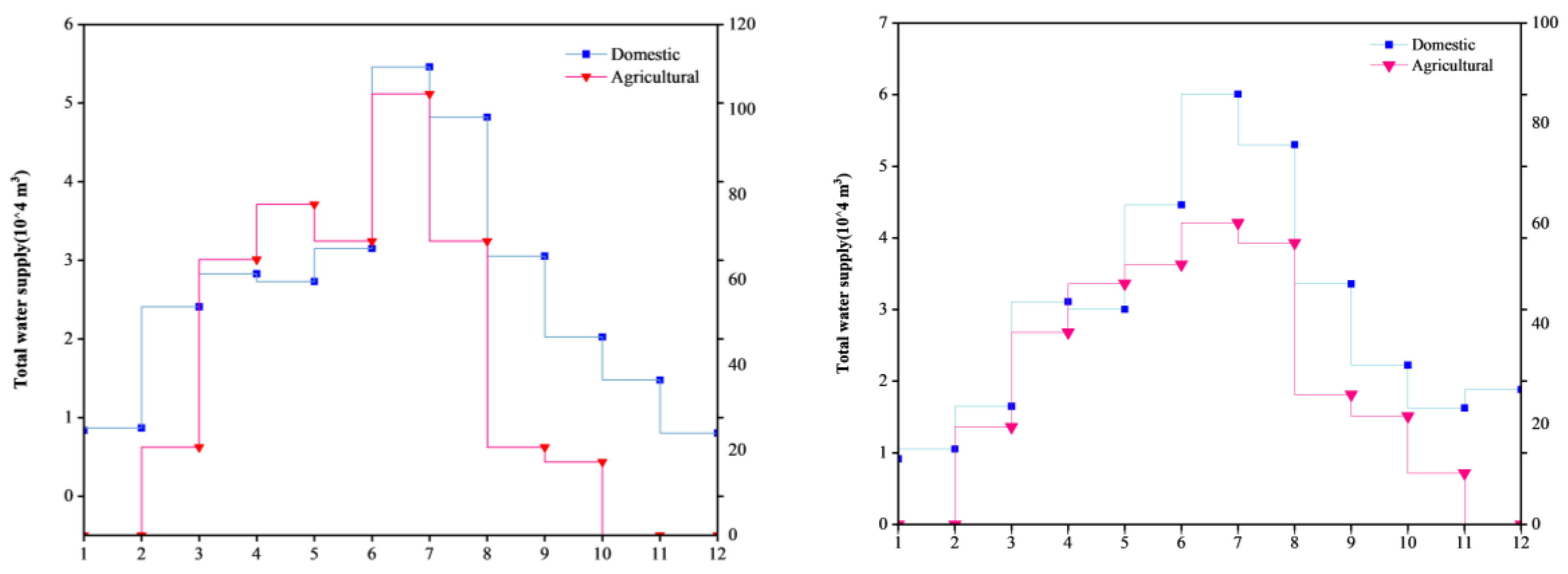
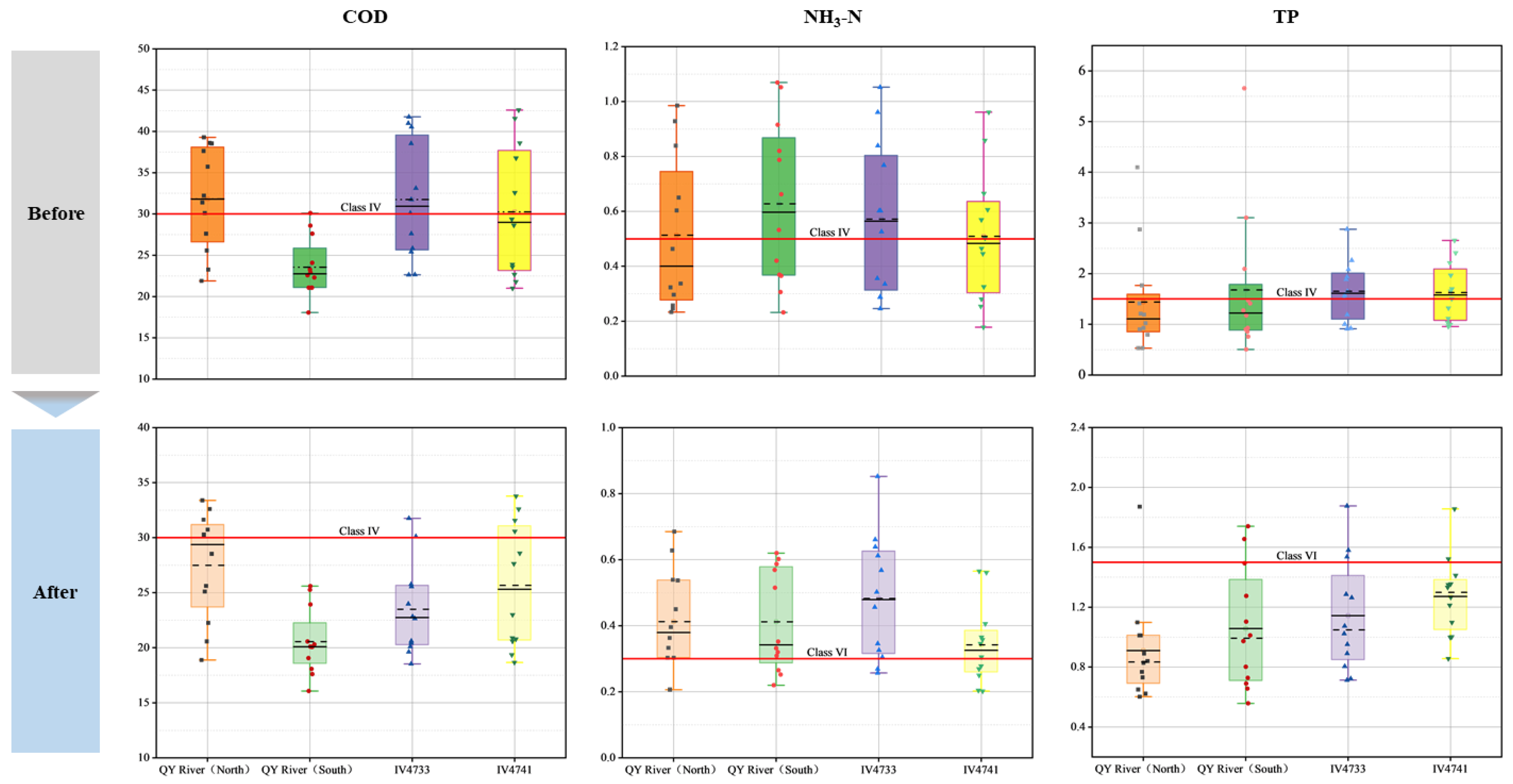

| Sampling Location | Water Quality Parameters | Sediment Quality Parameters (0~60 cm Average Value) | ||||
|---|---|---|---|---|---|---|
| COD | NH3-N | TP | TN | TP | TOC | |
| (mg/L) | (mg/kg) | |||||
| QY River North) | 26 | 0.5 | 0.8 | 1660 | 668 | 0.83 |
| QY River (South) | 21 | 0.9 | 1.01 | 2722 | 571 | 1.35 |
| Ⅳ-4733 | 44 | 4.1 | 0.9 | 1335 | 602 | 0.8 |
| Ⅳ-4741 | 31 | 2.5 | 0.7 | 1321 | 484 | 1.64 |
| Parameters | Sub Item | Data |
|---|---|---|
| Settlement type | Scattered | 1~3 households |
| Multi household | 4~10 households | |
| Settlement | >10 households | |
| Water resource allocation | Total flow rate | 3.9 m3/s |
| field leakage rate | 3~5 mm/d | |
| irrigation design guarantee rate | 90% | |
| irrigation quota | 519 m3/acre for rice | |
| 75 m3/acre for wheat | ||
| irrigation frequency | 17 times/a for rice | |
| 3 times/a for wheat | ||
| total irrigation amount | 1.1 × 108 m3/a | |
| water consumption | 220 L/per person·d | |
| water drainage | 187 L/per person·d | |
| Total water consumption | 2405 t/d | |
| Total water drainage | 2044 t/d | |
| Field-flooded drainage | flood standard | P = 5% |
| Peak | 23.1 m3/s | |
| Normal | 13.9 m3/s | |
| normal water level | 2.5 m | |
| flood level | 3.5 m | |
| warning water level | 3.8~4.0 m | |
| Adjustable storage capacity | 2 × 105 m3 |
| Certain Year | Water Demand | Water Supply | Water Shortage | Water Conservation | Water Balance Analyze |
|---|---|---|---|---|---|
| 2020 | 607 | 475 | −132 | 79 | −53 |
| 2023 | 589 | 501 | −89 | 62 | −27 |
| Hydrographic Parameter | Data |
|---|---|
| Maximum 3-day point rainfall average (mm) | 130 |
| Maximum 3-day point rainfall CV | 0.58 |
| Kp (p = 5%) | 2.16 |
| Design point rainfall (p = 5%) (mm) | 281 |
| Point-face conversion factor | 1 |
| Imax (Maximum initial loss) | 95 |
| a | 0.65 |
| pa | 61.75 |
| Cp | 20 |
| Ci | 115 |
| 3-day net surface rainfall (mm) | 212 |
| Permissible waterlogging time (h) | 24 |
| Pumping Station Name | Flow Rate (m3/s) | Irrigation Area (acres) | Head Lift (m) |
|---|---|---|---|
| WD | 1.1 | 3500 | 4.00 |
| YQ | 0.7 | 1890 | 3.30 |
| BT | 0.7 | 1552 | 3.70 |
Disclaimer/Publisher’s Note: The statements, opinions and data contained in all publications are solely those of the individual author(s) and contributor(s) and not of MDPI and/or the editor(s). MDPI and/or the editor(s) disclaim responsibility for any injury to people or property resulting from any ideas, methods, instructions or products referred to in the content. |
© 2024 by the authors. Licensee MDPI, Basel, Switzerland. This article is an open access article distributed under the terms and conditions of the Creative Commons Attribution (CC BY) license (https://creativecommons.org/licenses/by/4.0/).
Share and Cite
Ge, Q.; Zhu, C.; Hu, J.; Feng, G.; Huang, X.; Cheng, X. A Study on the Construction and Evaluation of the Water Resource Reutilization System for Farmland Diversion and Drainage. Water 2024, 16, 2289. https://doi.org/10.3390/w16162289
Ge Q, Zhu C, Hu J, Feng G, Huang X, Cheng X. A Study on the Construction and Evaluation of the Water Resource Reutilization System for Farmland Diversion and Drainage. Water. 2024; 16(16):2289. https://doi.org/10.3390/w16162289
Chicago/Turabian StyleGe, Qiuyi, Chengli Zhu, Jizhou Hu, Genxiang Feng, Xing Huang, and Xue Cheng. 2024. "A Study on the Construction and Evaluation of the Water Resource Reutilization System for Farmland Diversion and Drainage" Water 16, no. 16: 2289. https://doi.org/10.3390/w16162289
APA StyleGe, Q., Zhu, C., Hu, J., Feng, G., Huang, X., & Cheng, X. (2024). A Study on the Construction and Evaluation of the Water Resource Reutilization System for Farmland Diversion and Drainage. Water, 16(16), 2289. https://doi.org/10.3390/w16162289






